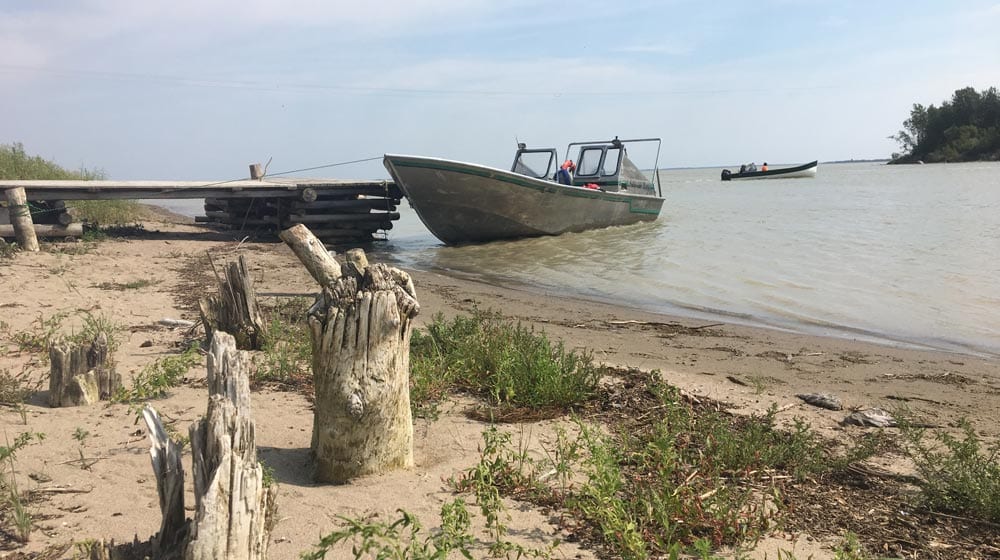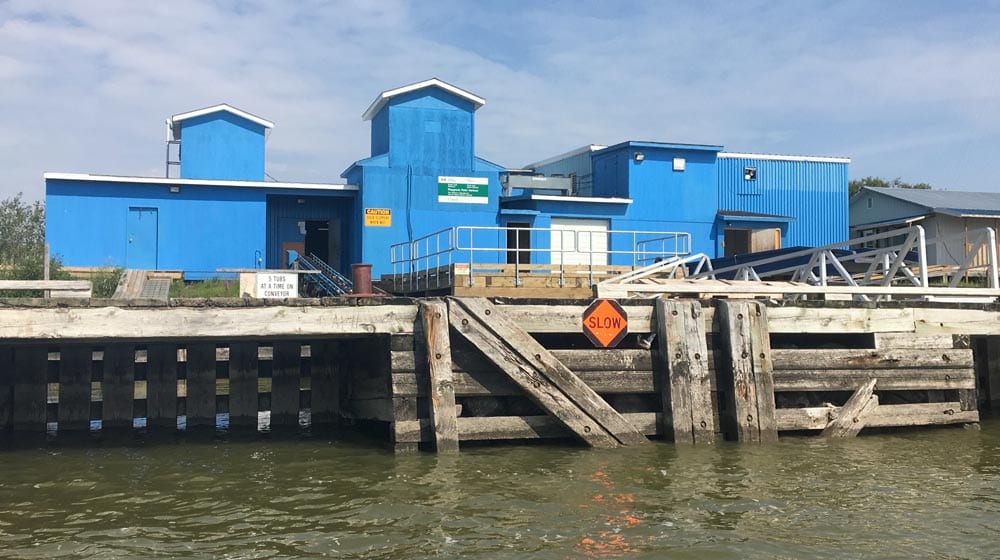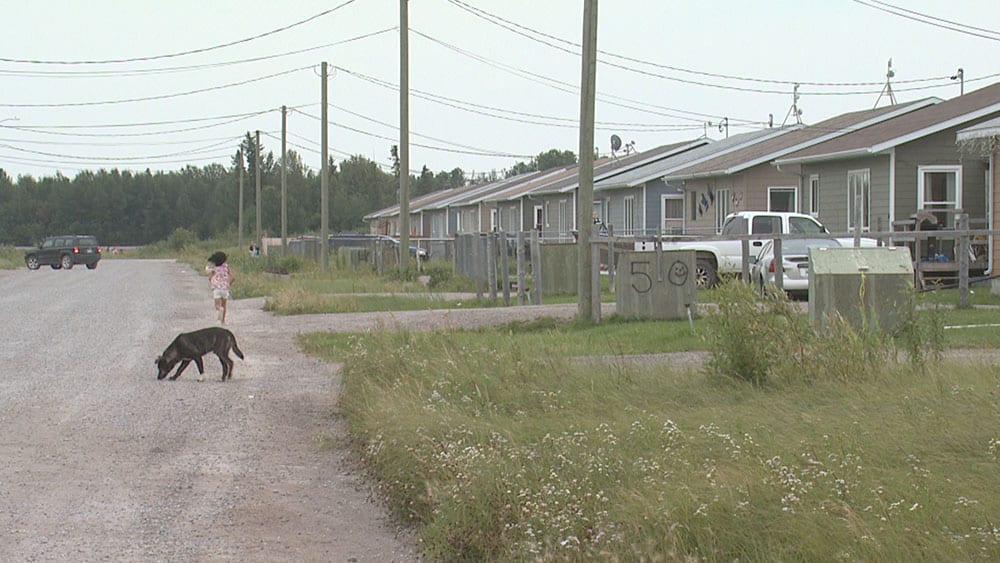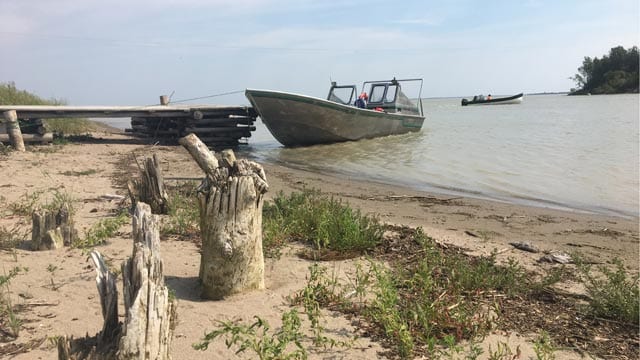
This is Part 2 of a series on hydro-impacted communities in Treaty 5 territory. Click here to access other stories featured in Power Failure: The impacts of hydro in Northern Manitoba.APTN News
It was mid-December, a few years back when Chris Clarke was out on snowmobile near his brother’s camp and trapline on Playgreen Lake.
He “hit an air pocket” and went through the ice into the shallow water below, he recalls.
“Almost drowned that time.”
His brother built a fire to warm Clarke up. The two spent hours trying to haul the brand new snowmobile out of the hole.
The father and fisherman “quit trapping for a couple years,” he says.
(Chris Clarke says despite his community’s settlement with Hydro, the waters are still polluted, fish populations are dwindling, and his people are struggling to hold on to their way of life. Photo: Justin Brake)
But the heightened dangers associated with waterways connected to hydroelectric development weren’t enough to keep Clarke away forever.
He returned to fishing and trapping, carrying on his family’s tradition and working to preserve his people’s way of life for future generations.
But that way of life has been threatened since the 1970s, he explains, when Manitoba Hydro began reengineering the lakes and rivers that Cree in Treaty 5 territory have lived along, and depended on, since time immemorial.
“We have to live with these changes every day…”
Clarke is president of the Norway House Fisherman’s Cooperative, which represents 50 local fishers who work in a struggling industry harvesting fish from Playgreen Lake, Lake Winnipeg and Kiskittogisu Lake.
Today he’s taking Wa Ni Ska Tan alliance members out in boat to show them the impacts hydro development has had on the waters and fisheries.
The boat weaves through a channel, a few kilometres outside of Norway House, with cabins and homes scattered along the shore.
A crane towers above the tall grasses along the banks and watches the boat pass by.
Minutes later the channel opens up, revealing beams of sunlight glimmering on Playgreen Lake’s pale green waters. There is slight wind.
The boat passes dozens of islands, some of them new, some reduced to the bedrock that once sat below their soil and vegetation, and others completely submerged underwater.
All of the islands have eroded as a result of fluctuating water levels controlled by Manitoba Hydro; they’re a danger to fishermen and others who use the lake, Clarke explains.
(The Norway House Fisherman’s Co-op, established in 1962, represents 50 commercial fishers from the Norway House area. Photo: Justin Brake/APTN)
A 20-minute boat ride takes the alliance members—there to witness and document the impacts of hydro development on local people and communities—to a small plant owned by the Fisherman’s Co-op.
It’s here the fishermen land their catches of whitefish, pickerel and sauger and package it for transportation by truck 800 kilometres to Winnipeg, where the fish is further processed and marketed.
Standing on the dock and peering out at the lake, Clarke says the co-op’s fishers are working with a significantly reduced quota and often struggle to make ends meet.
“The silting is killing this lake because it’s killing the oxygen: the plant life, the fish — the fish can’t spawn here anymore.”
(Lands were blasted and excavated to create Two-Mile Channel, which connects Playgreen Lake to Lake Winnipeg. Photo: Justin Brake/APTN)
He says sturgeon—culturally significant to the Cree but now listed as an endangered species—were once plentiful in the lake but have almost entirely disappeared since the wave of hydro development in the region four decades ago.
Clarke says trees are constantly falling into the lake due to the shoreline erosion, and that they pose a safety risk to fishermen.
As in other hydro-impacted communities, Manitoba Hydro pays locals from Norway House to retrieve trees and other debris in order to reduce the safety risk, he explains.
Fluctuating water levels also create air pockets beneath the ice in wintertime, like the one Clarke fell through a few years ago.
Some have given up fishing altogether, he says.
“We have to live with these changes everyday. Day in, day out, while we’re out here trying to make a living, providing for our families.”
Dispossessed by hydro
In the 1960s, Manitoba and the federal government jointly explored the hydro potential of the Nelson River as a source of power for the growing energy needs in the south.
The Nelson drains into Lake Winnipeg and runs more than 600 kilometres to Hudson Bay.
With a drainage basin that spans more than 1 million square kilometres across multiple provinces, it’s also an important waterway for the Cree, Metis and other Indigenous peoples in the region.
But by the 1970s, Manitoba Hydro had turned the river, its tributaries, and other waterways in the region into energy-and-profit-producing entities.
According to Hydro’s website, The Churchill River Diversion (CRD) “was created to increase the water flow to our large generating stations on the lower Nelson River”, with most of the Churchill’s flow “diverted at Southern Indian Lake into the Nelson River.”
Hydro describes a network of dams and channels that control the river’s flow into South Indian Lake and Split Lake, with the outcome being an average of “25% more water [flowing] into the Nelson River system.”
At the same time, as it was re-engineering the Churchill River system, Hydro also undertook the Lake Winnipeg Regulation (LWR), another massive engineering feat that “created a second outlet for Lake Winnipeg and a network of channels and structures,” according to Hydro’s website.
Hydro boasts that the Jenpeg dam and a series of diversion channels “increase [Lake Winnipeg’s] outflow potential by about 50%” and help “reduce overland flooding in summer.”
In writing, the Churchill River Diversion and Lake Winnipeg Regulation projects sound relatively harmless.
But for the Indigenous peoples whose existence and well-being are intimately connected to these waters, a reality of destruction, disorientation, and dispossession unfolded.
The Churchill River’s flow was completely reversed, affecting fish migration and spawning. Fish that did survive were found to have elevated levels of mercury.
Rivers and lakes people once travelled on, swam in and drank from, turned green after the flooding, their levels and currents unpredictable.
Those who carried traditional knowledge of the rivers and lakes’ nature and behaviour found themselves unable to navigate the waters.
Lands were flooded, including burial sites and other sacred spaces. People were uprooted from their ancestral homelands and forced to relocate to accommodate the new reservoirs.
Influxes of southerners to their communities during the construction phases of dams, powerlines and other infrastructure created social problems.
The Cree’s way of life was dramatically altered.
A 1993 report on the NFA prepared for the Royal Commission on Aboriginal Peoples describes the “systematic degradation of the local economy,” resulting from hydro development in the region.
“Many persons or households find themselves incapable of coping with economic and social disruption,” the report continues, explaining many were forced out of the traditional land-based economy and on to “welfare”.
(The Jenpeg generating station near Norway House Cree Nation. Photo: Ashley Brandson/APTN)
In Norway House, it was the Two- and Eight-Mile Channels that brought an influx of water into Playgreen and Little Playgreen Lakes from Lake Winnipeg.
And the 115-megawatt Jenpeg dam 100 kilometres north of the community that held those waters back.
Most of Norway House’s people, once members of a community at the heart of the 18th and 19th century fur trade, and in the 19th century the beneficiaries of a thriving fishery, began witnessing the end of a way of life.
The Northern Flood Agreement and broken promises
In 1974, as multiple dams were under construction on the Nelson River and flooding continued to devastate to Cree communities, the chiefs of five First Nations—Nelson House, Norway House, Cross Lake, York Landing and Split Lake—formed the Northern Flood Committee to negotiate compensation for their people.
In 1977 they signed the Northern Flood Agreement (NFA) with Manitoba Hydro, the Government of Manitoba, and the Government of Canada.
The NFA promised to compensate First Nations with reserve lands impacted by the flooding, chief among those promises “a commitment and schedule to investigate plans for alleviating mass unemployment and poverty in the communities,” says Peter Kulchyski, a professor of Native Studies at the University of Manitoba.
“And Article 6 was an open-ended commitment from the federal government to ensure a continuous supply of potable water that meet the federal government’s water, health and safety standards,” he adds.
Kulchyski, a co-founder of Wa Ni Ska Tan who has worked with hydro-impacted communities in northern Manitoba for more than two decades, says the NFA’s key commitments were never met.
“I think [Manitoba] Hydro thought they were going to make so much money they wouldn’t know what to do with it, and they were going to throw some money at these communities and they’d be fine,” he says.
But the promises proved too costly for Hydro, from a financial standpoint, Kulchyski explains.
“The community needs, and also the environmental impacts, I think were far greater than they anticipated,” he says, adding the provincial utility “still touts hydro as clean power — but that’s now in absolute denial.”
From Canada’s perspective, Kulchyski figures the feds were “very worried about their water commitment and the cost of that, especially when they saw that…it wasn’t going to be safe to drink the water from the river.
“So suddenly supplying fresh water to the communities was an expensive proposition,” he explains.
With provincial and federal governments and Manitoba Hydro largely unwilling or unable to fulfill their promises to the communities, they “went community by community, offering them various packages of some hundreds of millions of dollars,” Kulchyski continues, “if the communities would sign an agreement that said they would no longer pursue any legal action under the NFA.”
Four of the five NFA Nations, excluding Cross Lake, signed what Hydro has called “implementation agreements”.
Or, as Kulchyski calls them, “extinguishment agreements”.
“They are basically agreements saying ‘we won’t live up to our promises under the NFA and you’ll get some money instead,’” he says.
Cash compensation “never going to be enough”: councillor
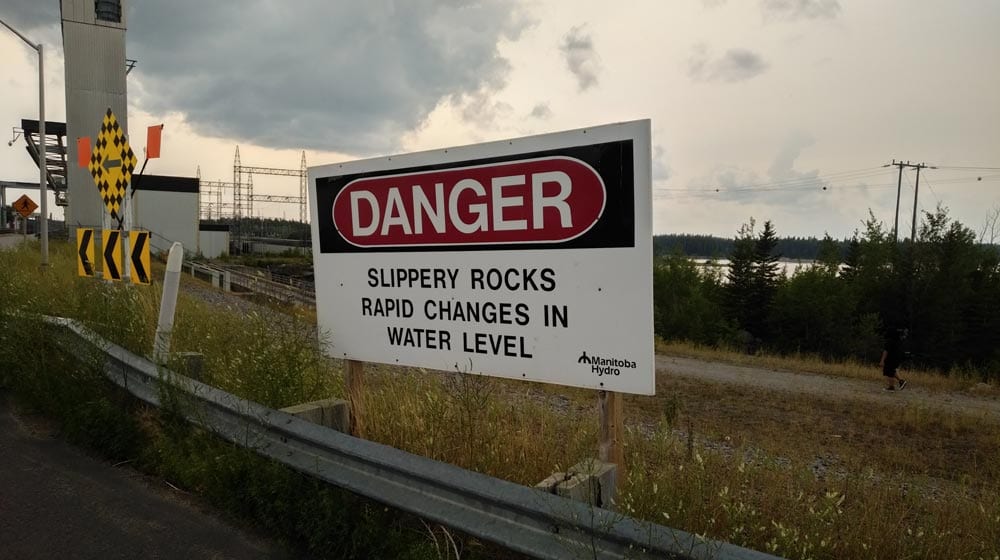
(A sign by the Jenpeg generating station warns of a rapidly changing water levels. Photo: Ashley Brandson/APTN)
Norway House signed its implementation agreement in 1997.
The $78.9 million deal compensated the community for the harms hydro had inflicted on its people.
Over the past 20 years the band has used the money to build housing, a multi-use facility, and to fund programs in the community.
Band councillor Langford Saunders says most of that money is now spent, though some remains invested but not generating as much interest as the band council hoped.
Yet with some new infrastructure and several now-defunct programs, Saunders says the impacts of hydro development on his community continue.
The beaches he grew up playing on are still gone due to the flooding.
The scarcity of safe places for young people to swim or fish, coupled with fear of getting sick from the once-clean waters, is still keeping youth off the land, he says.
Saunders, who was elected to council earlier this year, says he’s hopeful Hydro will work with his community to ensure the people of Norway House are compensated for the loss of their way of life.
At the same time, “it’s never going to be enough,” he says.
“My opinion is we can’t put a price on the loss of the activities we used to do prior to the construction of the two channels [on Playgreen Lake]. We’ve lost a lot, and there’s not enough compensation to compensate for that.”
Saunders says Hydro’s “commitment to support the community has to continue.”
APTN News requested an interview with Manitoba Hydro for this series. They declined, but spokesperson Bruce Owen emailed a written statement.
“We recognize the impact hydro-electric development has had on many Indigenous communities,” he says. “We also recognize that resolving past grievances is fundamental to strengthening our relationships with Indigenous communities.”
APTN also reached out to Manitoba’s Minister of Indigenous and Northern Relations, Eileen Clarke, who declined our interview request.
“Hydro has altered our way of life,” Clarke says, standing on the shore at Two-Mile Channel after showing Wa Ni Ska Tan members how Hydro re-engineered the land and waters between Playgreen Lake and Lake Winnipeg.
“It’s altered everything. And what upsets me is they don’t show us proper regard or respect,” he continues.
“Sure, the damage is done already, but how can we minimize it? How can we help the lake survive?
“Someday I want to see my grandchildren…or my sons, continue this way of life that I’ve enjoyed.
“Trapping, hunting, fishing. It’s who we are as Cree people. The lake and the land were loaned to us by the Creator for us to survive. I want people to understand that. Life is not all rosy, and we have issues to deal with, but we try our best to live.”



